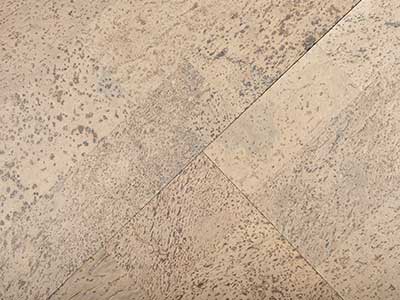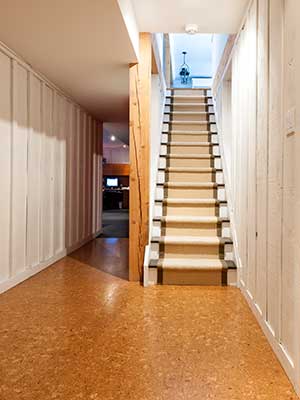Back to Floor Sanding
Cork Floor Sanding & Restoration Explained
 Cork flooring is a beautiful, warm, and natural flooring solution. Its unique texture and eco-friendly properties make it a popular choice. However, to maintain its charm and extend its lifespan, periodic restoration is essential. This guide will walk you through the steps of restoring cork floors, including sanding, sealing, and repair techniques.
Cork flooring is a beautiful, warm, and natural flooring solution. Its unique texture and eco-friendly properties make it a popular choice. However, to maintain its charm and extend its lifespan, periodic restoration is essential. This guide will walk you through the steps of restoring cork floors, including sanding, sealing, and repair techniques.
Understanding Your Cork Flooring
Before starting the restoration process, it is crucial to understand the type of cork flooring you have.
- Solid vs Engineered Cork Flooring: Only solid cork flooring is suitable for sanding. Engineered cork floors have a thin veneer that may not be suitable for sanding.
- Check Thickness: Ensure that your cork tiles are thick enough to withstand sanding. Typically, the tiles should be at least 4mm thick for safe sanding.
- Tile Replacement: If any tiles are damaged, replace them first and ensure the glue is completely dry before beginning the sanding process.
Cork Floor Sanding Process
Sanding cork floors is a delicate task, requiring precision and care.
- Use Professional Equipment: A professional-grade belt sander and orbital sander are essential to ensure an even and smooth sanding process.
- Initial Grit Selection: Since cork is softer than hardwood, start with a gentle abrasive, such as 40 or 60 grit, to avoid damaging the surface.
- Gradual Grit Progression: Sand the floor to a finer grit (up to 120 or 150) to achieve a smooth, polished surface. Buffing the floor at this stage is recommended for an even finish.
- Buffing Between Sanding Stages: Buffing helps smooth the surface further and prepares it for the next step in the restoration process.
Sealing Cork Flooring
Once the floor is sanded and smooth, sealing is vital to protect the cork from future damage.
- Vacuuming the Floor: Thoroughly vacuum the surface to remove all dust and debris before applying any sealant.
- Choosing the Right Sealant: Water-based polyurethane finishes are most commonly recommended for cork, as they offer durability and enhance the natural appearance. Alternatives like hardwax oils or natural oils can be used but are less common.
- Application of Sealant: Apply multiple coats of sealant, allowing each layer to dry completely. A light buff between coats ensures a smooth finish.
- Final Coat Buffing: After the final coat, lightly buff the surface to achieve a flawless, polished appearance.
Common Issues and Repairs
 Cork flooring is resilient but may occasionally need repairs due to wear and tear.
Cork flooring is resilient but may occasionally need repairs due to wear and tear.
- Minor Scratches and Scuffs: For superficial scratches, light sanding followed by resealing is often enough to restore the surface.
- Deep Scratches and Dents: More severe damage may require replacing individual tiles or sanding down the affected area before refinishing.
- Water Damage: Cork is naturally moisture-resistant, but excessive exposure to water can cause warping or mould growth. Address any water damage promptly by removing affected tiles, drying the area, and replacing damaged sections.
Maintenance Tips for Cork Flooring
Regular maintenance can greatly extend the lifespan of your cork flooring.
- Cleaning: Sweep or vacuum your cork floors regularly to prevent dirt and debris from scratching the surface. Use a damp mop for cleaning, but avoid excess water.
- Avoid Harsh Chemicals: Do not use abrasive or chemical-based cleaners, as they can damage the sealant and compromise the cork's natural integrity.
- Furniture Protection: Use felt pads on the bottom of furniture legs to prevent dents and scratches.
- Reapplication of Sealant: Every few years, depending on foot traffic, reapply a coat of sealant to maintain the protective layer and enhance the floor’s appearance.
Professional vs. DIY Cork Floor Restoration
Restoring cork floors can be a DIY project, but there are risks involved.
- Pros of Professional Services: Professional restoration ensures that sanding, sealing, and repairs are done with precision, minimising the risk of damaging the cork.
- Cons of DIY Restoration: While DIY restoration may save money, improper sanding can result in irreparable damage. The softness of cork makes it particularly vulnerable to uneven sanding or using the wrong grit paper.
- When to Call a Professional: If your cork floor is deeply scratched, uneven, or requires significant repair, hiring a professional is the best way to ensure the floor is restored to its former glory.
A thorough cork floor restoration process, including careful sanding and proper sealing, can rejuvenate your flooring and extend its lifespan. By following the correct procedures and ensuring regular maintenance, your cork floors can continue to look beautiful for many years.